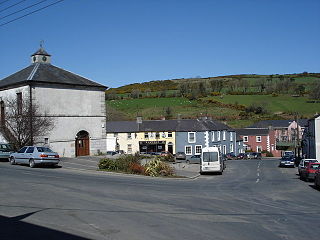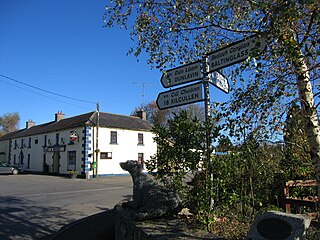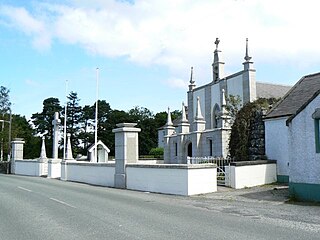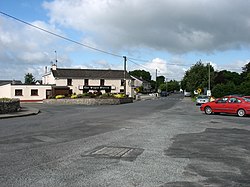
Knock is a village in County Mayo, Ireland.

Bray is a coastal town in north County Wicklow, Ireland. It is situated about 20 km (12 mi) south of Dublin city centre on the east coast. It has a population of 33,512 making it the tenth largest urban area within Ireland. Bray is home to Ardmore Studios, and some light industry is located in the town, with some business and retail parks on its southern periphery. Commuter links between Bray and Dublin are provided by rail, Dublin Bus and the M11 and M50 motorways. Parts of the town's northern outskirts are in County Dublin.

Kilmacanogue, officially Kilmacanoge, is a village in north County Wicklow, Ireland. It is southwest of Bray and is overlooked by Great Sugar Loaf mountain.

Tinahely is a village in County Wicklow in Ireland. It is a market town in the valley of the River Derry, a tributary of the River Slaney.

The Wicklow County Board of the Gaelic Athletic Association (GAA) or Wicklow GAA is one of the 32 county boards of the GAA in Ireland, and is responsible for Gaelic games in County Wicklow. The county board is also responsible for the Wicklow county teams.
The Leinster Council is a provincial council of the Gaelic Athletic Association sports of hurling, Gaelic football, camogie, rounders and handball in the province of Leinster. The Leinster Council has been partnered with the European County Board to help develop Gaelic Games in Europe. Leinster Council's main contribution to this goal is the provision of referees.
The 1970 All-Ireland Senior Hurling Championship was the 84th staging of the All-Ireland Senior Hurling Championship, the Gaelic Athletic Association's premier inter-county hurling tournament. The championship began on 3 May 1970 and ended on 6 September 1970.

Donard is a small village in County Wicklow, Ireland, located at the northern end of the Glen of Imaal, in the western part of the Wicklow Mountains.

Grangecon is a village in County Wicklow, Ireland. It has a population of about 200 people, and is located between Baltinglass and Dunlavin.

Stratford-on-Slaney, also known as Stratford or Stratford-upon-Slaney, is a small village on the River Slaney in west County Wicklow in Ireland. It was built by the Earl of Aldborough from 1774. According to the census, the village had a population of 241.

Rathdangan is a village in County Wicklow, Ireland. It is in the Electoral Division of Rathdangan, in Civil Parish of Kiltegan, in the Barony of Upper Talbotstown.

The Walsh Cup is an annual hurling competition staged in Ireland by the Leinster Council of the Gaelic Athletic Association (GAA) since 1954. Contested by the top county teams from the provinces of Leinster, Ulster and Connacht, the tournament consists of a round-robin group stage, followed by a knockout stage. Formerly sponsored by Bord na Móna, it was known as the "Bord na Móna Walsh Cup" and is now the "Dioralyte Walsh Cup" since 2024. Prior to 2018, third-level colleges also competed.

Lacken or Lackan is a townland and small village in the west of County Wicklow, Ireland, located on the shores of the Blessington lakes and western edge of the Wicklow Mountains.

Valleymount is a small village in western County Wicklow, Ireland. The name 'Valleymount' does not appear before 1839. Previously, the village was known as 'the Cross of Ballymore' or simply 'the Cross', with 'cross' referring to land belonging to the church.
Bree is a village located in the centre of County Wexford, in Ireland. As of the 2022 census, Bree had a population of 316 people.

Aghavannagh is a small village and townland in south County Wicklow, Ireland. It is located in the barony of Ballinacor South on the Military Road originally constructed between 1804 and 1809, in the wake of the 1798 rebellion. It is so remote that inhabitants say that "Aghavannagh is the last place God made".
This is a list of coats of arms of Ireland. In the majority of cases these are arms assigned to county councils created by the Local Government (Ireland) Act 1898 or later legislation, either by the Chief Herald of Ireland in what is now the Republic of Ireland or by the College of Arms in Northern Ireland. All but two county councils in the Republic have a coat of arms. In Northern Ireland, county councils were abolished in 1973, but the traditional arms are still occasionally used.

Redhills is a village located in northern County Cavan, Ireland. It is near the N54 road and is home to Redhills GAA club, which has produced four Cavan Inter-County players. The Finn River flows a short distance to the north of Redhills.
Cabinteely is a Dublin GAA And Dublin Camogie club based in Kilbogget Park which serves the Cabinteely / Johnstown / Killiney / Cherrywood / Ballybrack / Loughlinstown areas of Dublin, Ireland.
The Wicklow county hurling team represents Wicklow in hurling and is governed by Wicklow GAA, the county board of the Gaelic Athletic Association. The team competes in the Christy Ring Cup and the National Hurling League.

















